This baked popcorn chicken salad recipe contains tender chicken bites that are breaded and seasoned. After baking the chicken to crisp perfection, I’ve piled it high atop a bowl of baby greens and mustardy microgreens. Fresh radish slices, sunflower seeds, tangy feta, and a zingy honey mustard dressing are the finishing touches on this healthier salad with popcorn chicken. So easy and delicious!
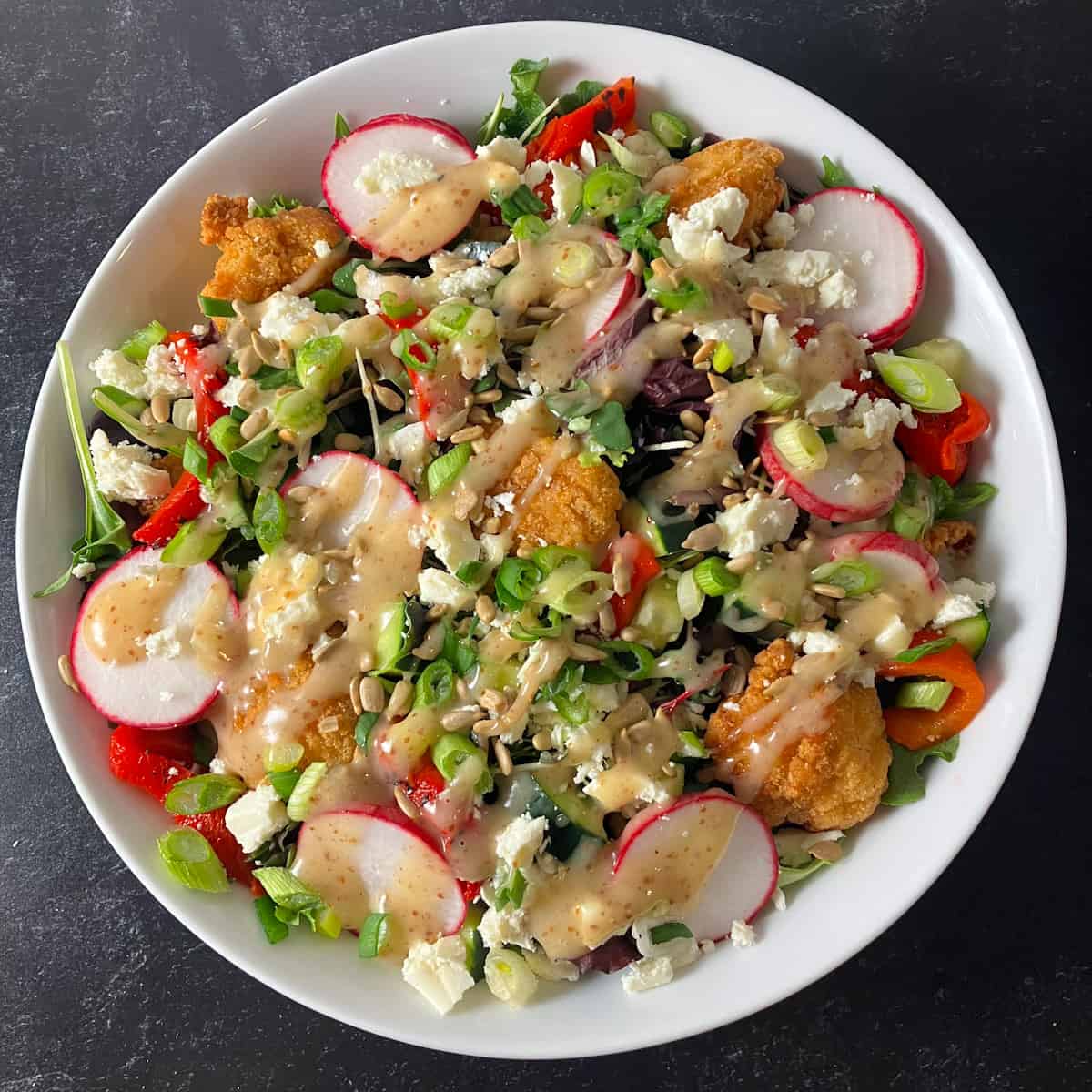
Want to save this post?
Enter your email below and we'll send it straight to your inbox. Plus you'll get great new recipes from us every week!
This popcorn chicken and vegetable salad is a healthy way to enjoy popcorn chicken. Typically, popcorn chicken is battered or breaded and then fried. Here, I’ve cut the need for added oils by baking the breaded chicken instead.
Additionally, fried or baked popcorn chicken is often served with other fried foods (like french fries), plus a sugary dip. When you put popcorn chicken in a salad instead, you’ve got a much healthier substitute for takeout popcorn chicken.
Please don’t misunderstand me, though. What you are getting is not a copycat recipe of the popcorn chicken at KFC or another purveyor of chicken. I’m hoping that you and your family find this recipe to be delicious in its own right.
This popcorn chicken salad bowl is great to take to work or for school lunch. It makes a great meal prep (as long as you keep the salad dressing separate until serving time).
Table of Contents
- 📋 Popcorn Chicken Salad Calories
- 🥗 Popcorn Chicken Salad Ingredients
- 💡 How to Cook Popcorn Chicken
- 🔪 How to Make Salad with Popcorn Chicken
- 🌡️ How to Store Popcorn Chicken Salad
- 🐔 Is popcorn chicken healthy?
- 🥬 What goes well with popcorn chicken?
- FAQs
- 👩🏻🍳 Other Salad Ideas with Chicken
- 📖 Recipe Card
- 💭 Expert Tips from Dietitian Summer Yule
- 💬 Comments
📋 Popcorn Chicken Salad Calories
What are the calories in popcorn chicken salad? One serving of my popcorn chicken salad recipe has 492 calories, 28.6 grams net carbs, and 26.4 grams of protein. Nutrition information for your salad depends on the brand of popcorn chicken and type of salad dressing you use.
🥗 Popcorn Chicken Salad Ingredients
What do you need to make popcorn chicken salad? Here is your shopping list:
- Cooked popcorn chicken
- Baby lettuce mix
- Microgreens
- Cucumber
- Roasted red pepper strips
- Radishes
- Crumbled feta cheese
- Scallions
- Toasted sunflower seeds (no shell)
- Honey mustard dressing
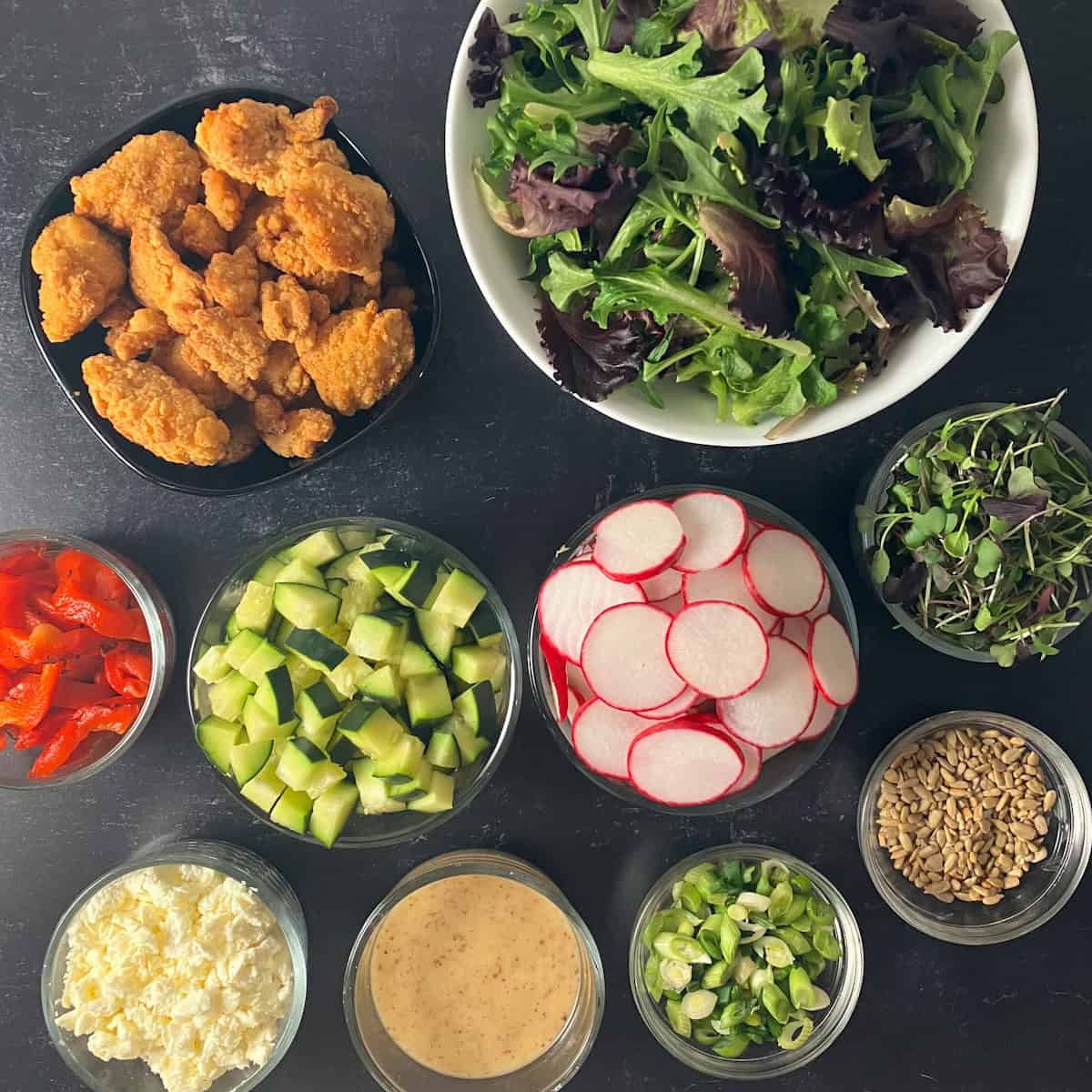
Specific quantities of ingredients are in the recipe card at the bottom of the post.
I used Tyson popcorn chicken Any’tizers for this recipe, but your favorite brand of popcorn chicken will also work. Homemade popcorn chicken from scratch is also a great choice here.
My microgreens mix in this salad contains various spicy red and green mustard leaves. If you cannot find microgreens in your local stores, I highly recommend growing your own. They grow fast- it takes only about two weeks for them to get to maturity.
Another option is to use sprouts in place of the microgreens. Check out this post for easy directions on how to grow broccoli sprouts.
The kitchen equipment you need for this salad includes:
- Baking sheet or air fryer (to cook the popcorn chicken)
- Good knife
- Large salad containers
I recommend getting salad bowls with separate lidded dressing cups to make transport easy. If you do a lot of meal prepping, you’ll find you use them often.
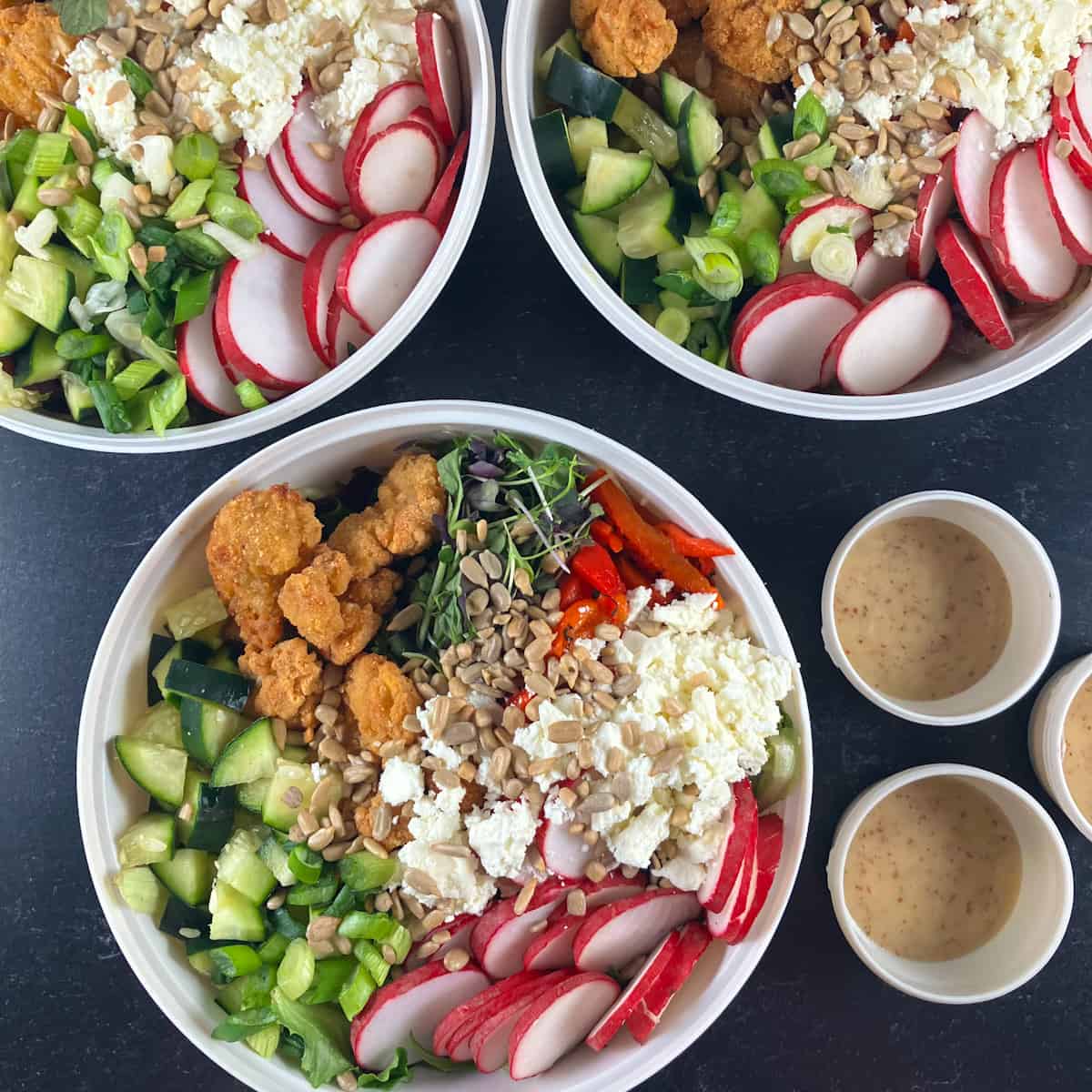
💡 How to Cook Popcorn Chicken
First up, you need to cook 1 lb (454 grams) of frozen popcorn chicken. You can follow my directions for frozen popcorn chicken in air fryer, or do one of these:
Frozen Popcorn Chicken in Ninja Foodi
Preheat the Ninja Foodi to 400F (200C). Put the frozen popcorn chicken in the air fryer basket. Bake for 8-10 minutes, flipping (or shaking) the chicken halfway through cooking time.
Cooked popcorn chicken will reach a minimum safe internal temp of 165F (74C). Use a meat thermometer to check. IMHO, this is the best way to cook popcorn chicken, because it’s fast and crisps up nicely.
Cook Frozen Popcorn Chicken in Oven
Preheat the oven to 400F (200C). Place the frozen popcorn chicken on a baking sheet. Bake popcorn chicken for 15-20 minutes until safe temp of 165F (74C) is reached.
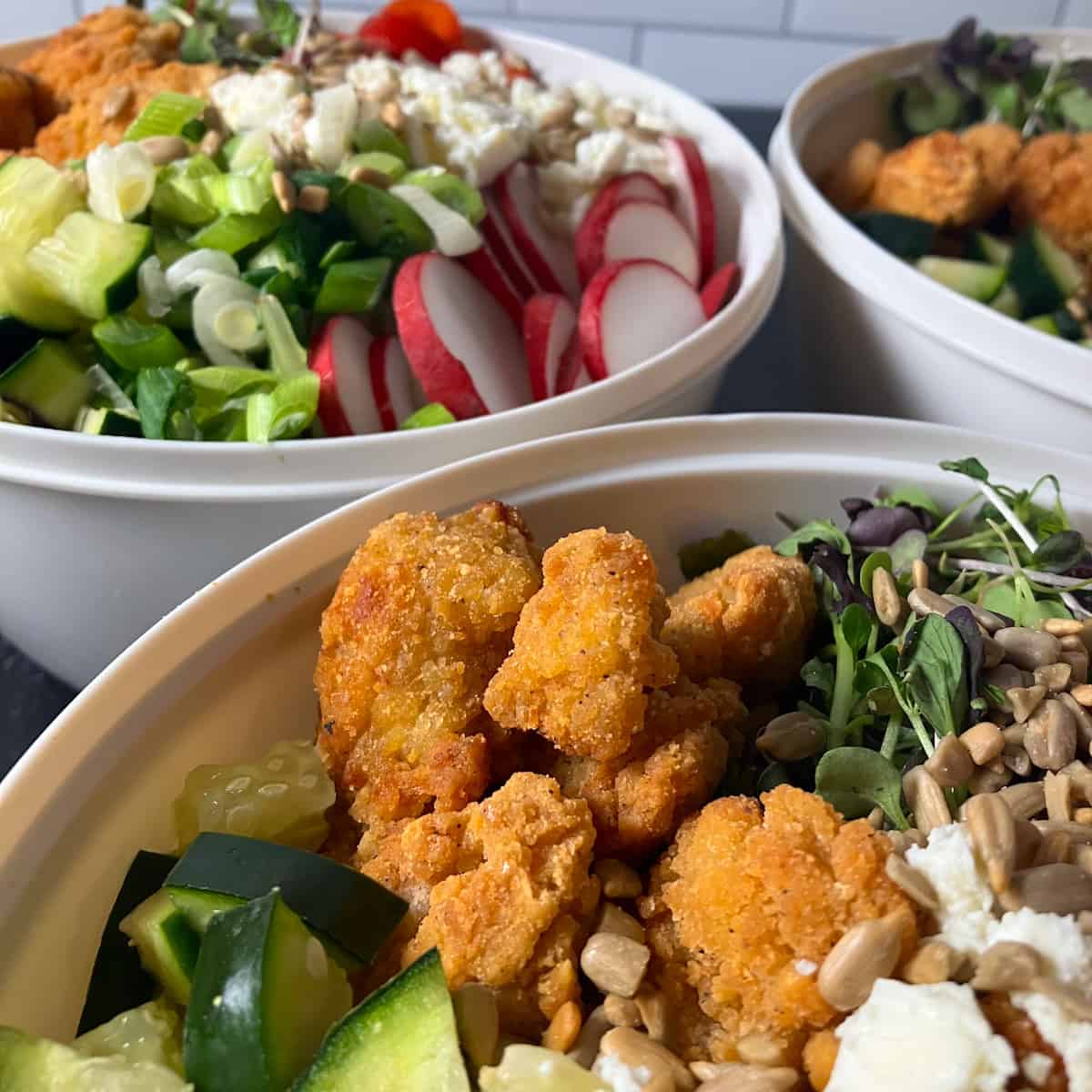
Cook Frozen Popcorn Chicken in Microwave
Put the frozen popcorn chicken on a microwave safe plate. (You may need to cook it in batches.)
Microwave 9 pieces at a time for 2.5-3 minutes on high. Let the chicken rest for 1-2 minutes before adding to salads. Note: this is my least favorite way to cook popcorn chicken, as it doesn’t crisp up as much.
🔪 How to Make Salad with Popcorn Chicken
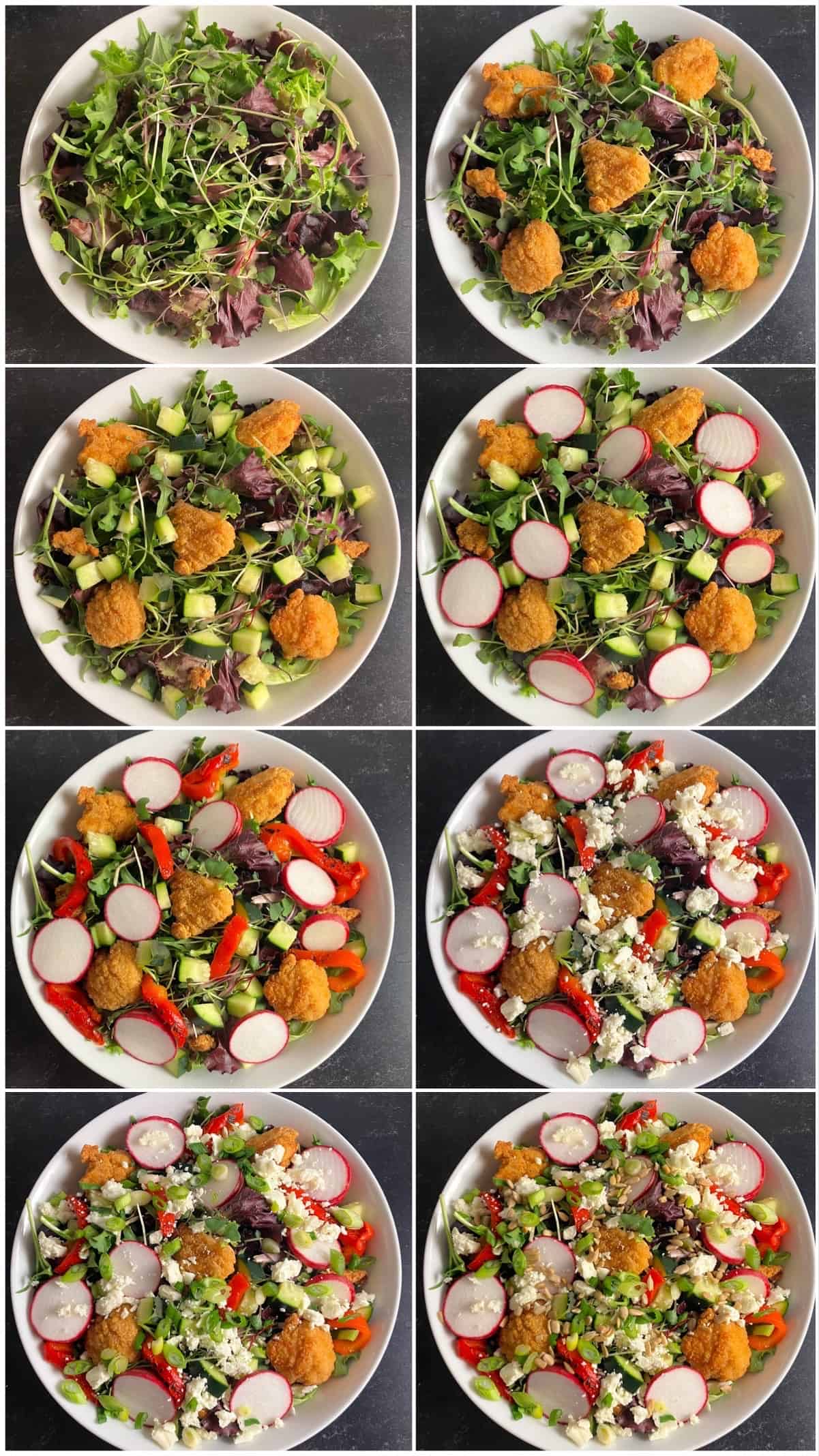
Here are the steps to make a tasty popcorn chicken salad:
- Cook the popcorn chicken using the directions on the packaging (or the instructions above).
- Chop the cucumber, thinly slice the radishes and scallions, and cut the roasted red peppers into strips.
- Divide the baby lettuce between four salad bowls or meal prep containers.
- Top each salad container with ¼ each of the baked popcorn chicken, microgreens, cucumber, roasted red pepper, scallions, radish, feta, and sunflower seeds.
- Drizzle the salads with honey mustard salad dressing right before eating. Enjoy!
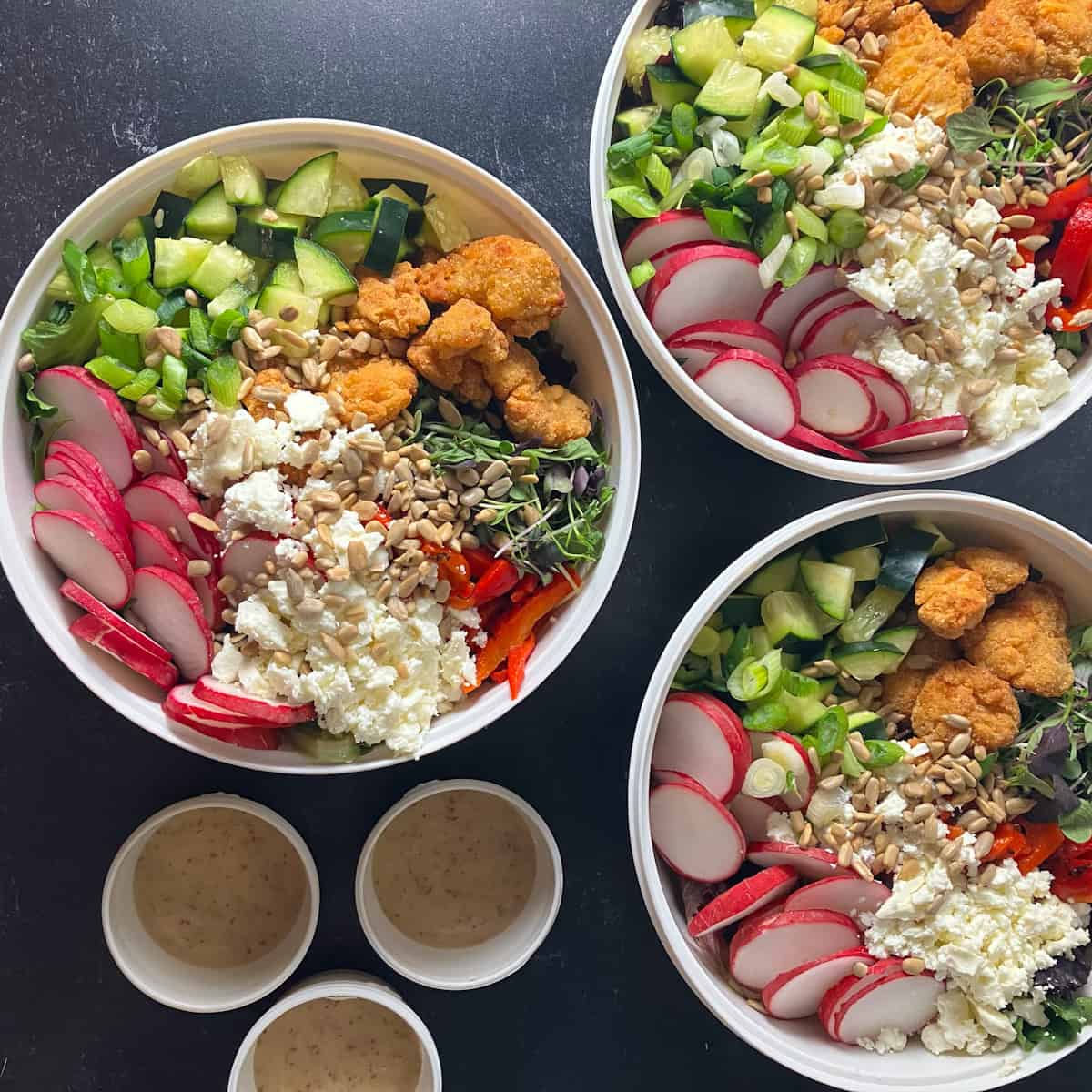
🌡️ How to Store Popcorn Chicken Salad
You can keep popcorn chicken salad in a covered container in the fridge for up to 3-4 days. Keep the salad dressing in a separate container until right before serving.
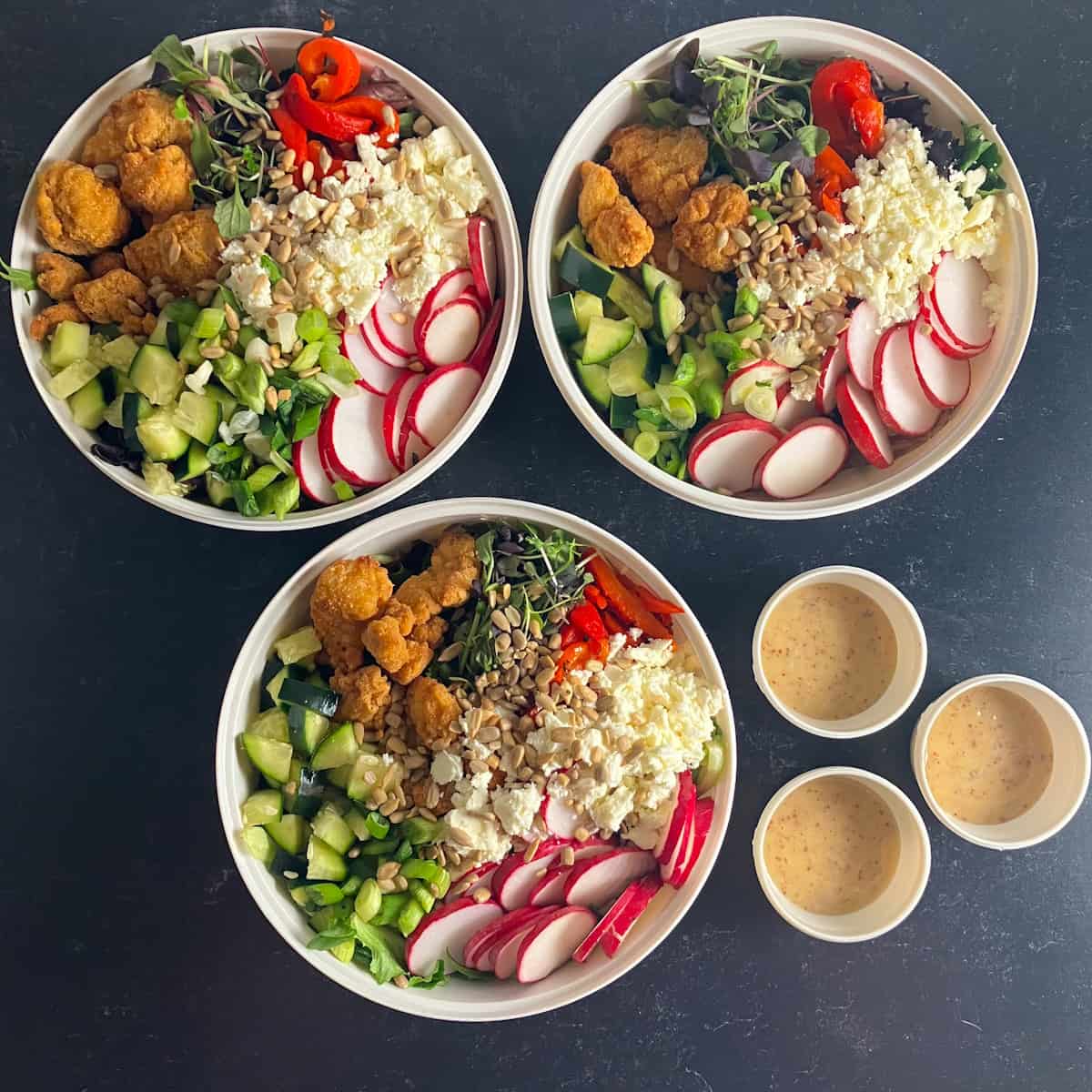
🐔 Is popcorn chicken healthy?
"Healthy” always depends on what your individual needs are. If you’re looking for the most nutrient-dense option, roasted chicken without breading may be a better choice. Popcorn chicken tends to contain a lot of white flour that doesn’t add a lot nutritionally to foods.
🥬 What goes well with popcorn chicken?
Wondering what to have with popcorn chicken? There are lots of different spins you can put on a salad with popcorn chicken.
For example, you could make a Buffalo popcorn chicken salad by using buffalo sauce and ranch dressing. Or how about a Chinese chicken salad with mandarin oranges and chow mein noodles? You could even substitute the popcorn chicken for air fryer chicken nuggets.
Here are some other foods to add to popcorn chicken salad:
- Red cabbage
- Shredded carrots
- Edamame
- Pickled jalapenos
- Banana peppers
- Teriyaki sauce
- Caesar dressing
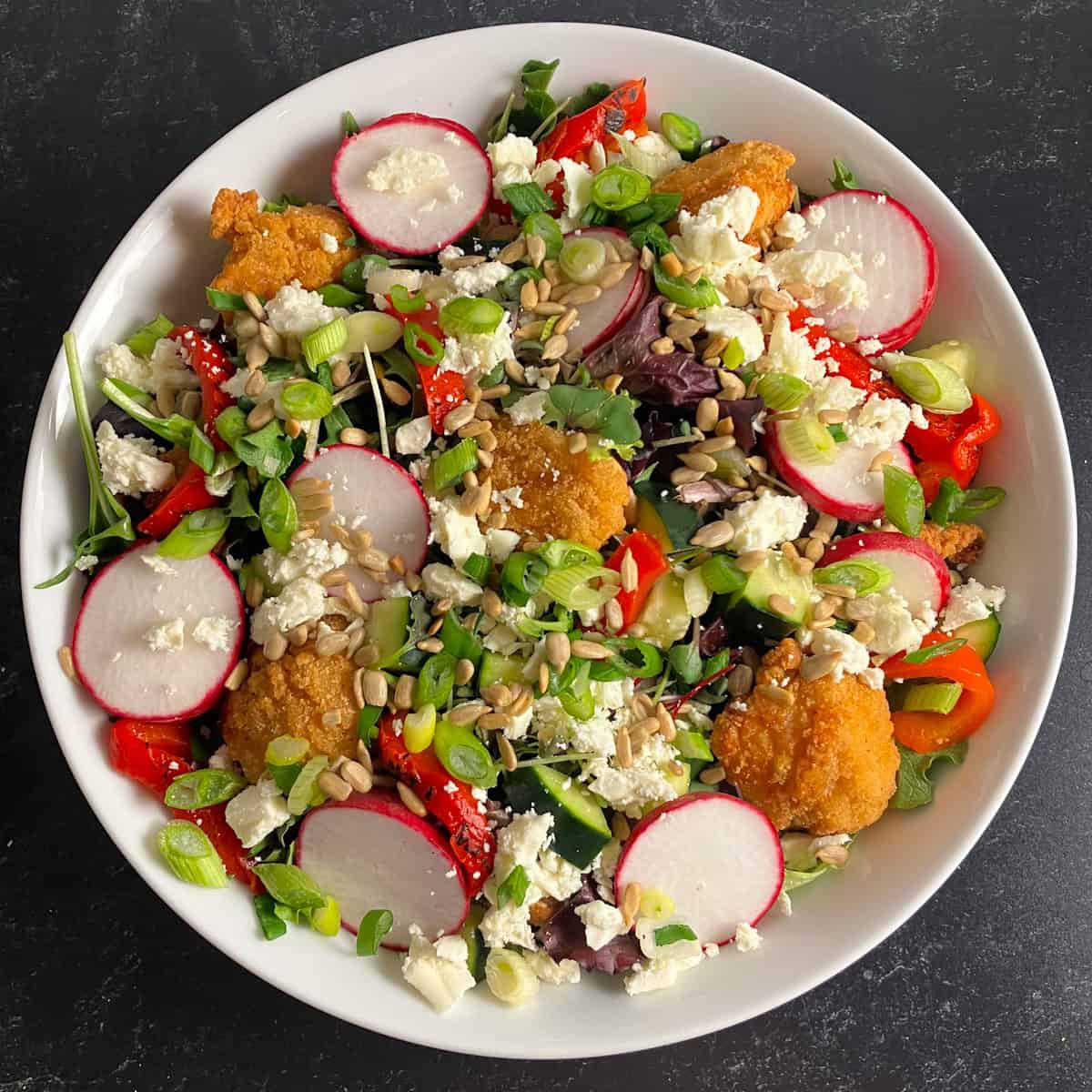
FAQs
How to make popcorn chicken salad gluten free?
To make gluten free popcorn chicken salad, you need to ensure the popcorn chicken and salad dressing are gluten free. Here are some gluten free chicken nuggets you can use, and here is a gluten free honey mustard vinaigrette.
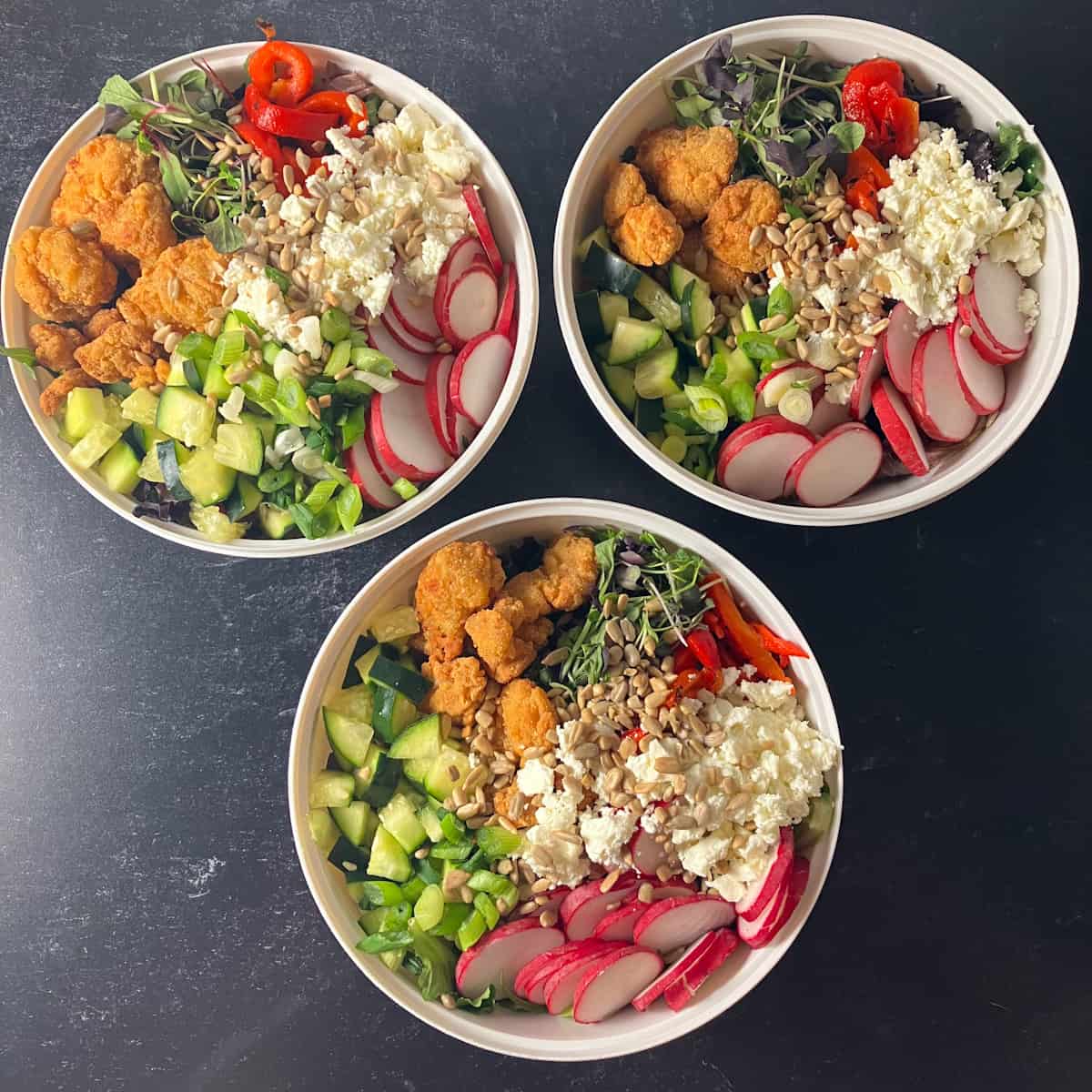
How to make popcorn chicken salad keto?
To make keto popcorn chicken salad, you need to ensure the popcorn chicken and salad dressing are very low carb. Make this keto orange chicken without the sauce for keto popcorn chicken. For the dressing, you can use this keto-friendly option.
Where to get popcorn chicken salad near me?
Many chain restaurants have options for crispy chicken salads with chicken nuggets, chicken tenders, or chicken crispers. For example, you can get Chick-Fil-A's cobb salad with nuggets, Friendly’s crispy chicken salad, or Chili’s Santa Fe crispers salad.
What are the KFC chicken salad calories?
KFC doesn’t currently offer chicken salad. The KFC popcorn chicken salad bowl (AKA KFC famous bowl) provides 840-1120 calories.
How to make popcorn chicken pasta salad?
The Salty Marshmallow has a popular popcorn chicken bacon ranch pasta salad you may want to try. (I mean, with bacon, ranch, popcorn chicken, and pasta, how could you go wrong? Yum!)
👩🏻🍳 Other Salad Ideas with Chicken
Here are a few more salads with chicken you may enjoy:
- Chick-Fil-A Southwest Chicken Salad
- Air Fryer Salad Recipe
- Orange Chicken Salad with Strawberries
- Canned Whole Chicken Salad
📖 Recipe Card
Watch How to Make It!
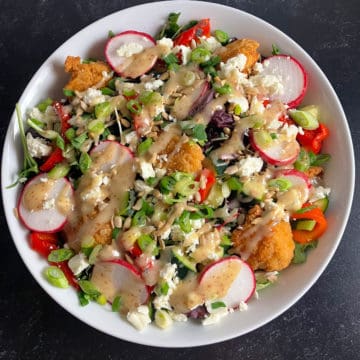
Popcorn Chicken Salad Recipe (Salad with Popcorn Chicken)
Ingredients
- 1 lb. popcorn chicken 454 grams
- 8 cups baby lettuce mix
- 1 cup microgreens
- 1 medium cucumber about 10½ ounces/298 grams
- 5 ounces roasted red peppers, sliced 142 grams (from a jar)
- 4 scallions, sliced
- 10-12 small radishes about 12 ounces/340 grams
- 4 ounces feta, crumbled 113 grams
- 4 tablespoons sunflower seeds, roasted (no shells)
- 8 tablespoons honey mustard dressing
Instructions
- Cook the popcorn chicken using the directions on the packaging. (See article above for Ninja Foodi, oven, or microwave directions.)
- Chop the cucumber, thinly slice the radishes and scallions, and cut the roasted red peppers into strips.
- Divide the baby lettuce between four salad bowls or meal prep containers.
- Top each salad container with ¼ each of the baked popcorn chicken, microgreens, cucumber, roasted red pepper, scallions, radish, feta, and sunflower seeds.
- Drizzle the salads with honey mustard salad dressing right before serving. Enjoy!
Equipment
Notes
💭 Expert Tips from Dietitian Summer Yule
This is a level 1 recipe (may help support fat loss). Salads that include a lot of non-starchy veggies are a great way to get a low-calorie, high-volume meal! If you need a higher energy meal, switch to whole milk feta. I used to make a version of popcorn chicken salad that included all kinds of goodies like blue cheese, whole grain croutons, and homemade crispy onions. (Scrumptious and so rich!) Adding any of those to your salad is another easy and tasty way to boost calories if you have higher energy needs. Normally, I place foods with white flour (such as popcorn chicken) in level 3. However, I’m using this recipe as an example that what the whole meal looks like is more important than an individual food. (And honestly, what the whole day, week, month, etc looks like is even more important than one meal.) If you serve popcorn chicken as most do, with fries or tater tots and sugary BBQ sauce or ketchup, you’re getting a low volume meal for the calories. By adding a bunch of fresh veggies instead of fries, we’re making a big, nutritious meal for under 500 calories. If you enjoy popcorn chicken but have a weight loss goal, putting it on a salad may be a smart move. High volume salads with adequate protein may help you feel full on fewer calories, helping you maintain the calorie deficit you need for weight loss. If you don’t feel like a salad, another option is to choose low-oil side dishes packed with non-starchy vegetables. Nutrition information for your salad depends on the brand of popcorn chicken and type of salad dressing you use.
nutrition info disclaimer
All recipes on this website may or may not be appropriate for you, depending on your medical needs and personal preferences. Consult with a registered dietitian or your physician if you need help determining the dietary pattern that may be best for you.
The nutrition information is an estimate provided as a courtesy. It will differ depending on the specific brands and ingredients that you use. Calorie information on food labels may be inaccurate, so please don't sweat the numbers too much.
"To taste" means to your preferences, which may have to be visual to follow food safety rules. Please don't eat undercooked food x
Nutrition
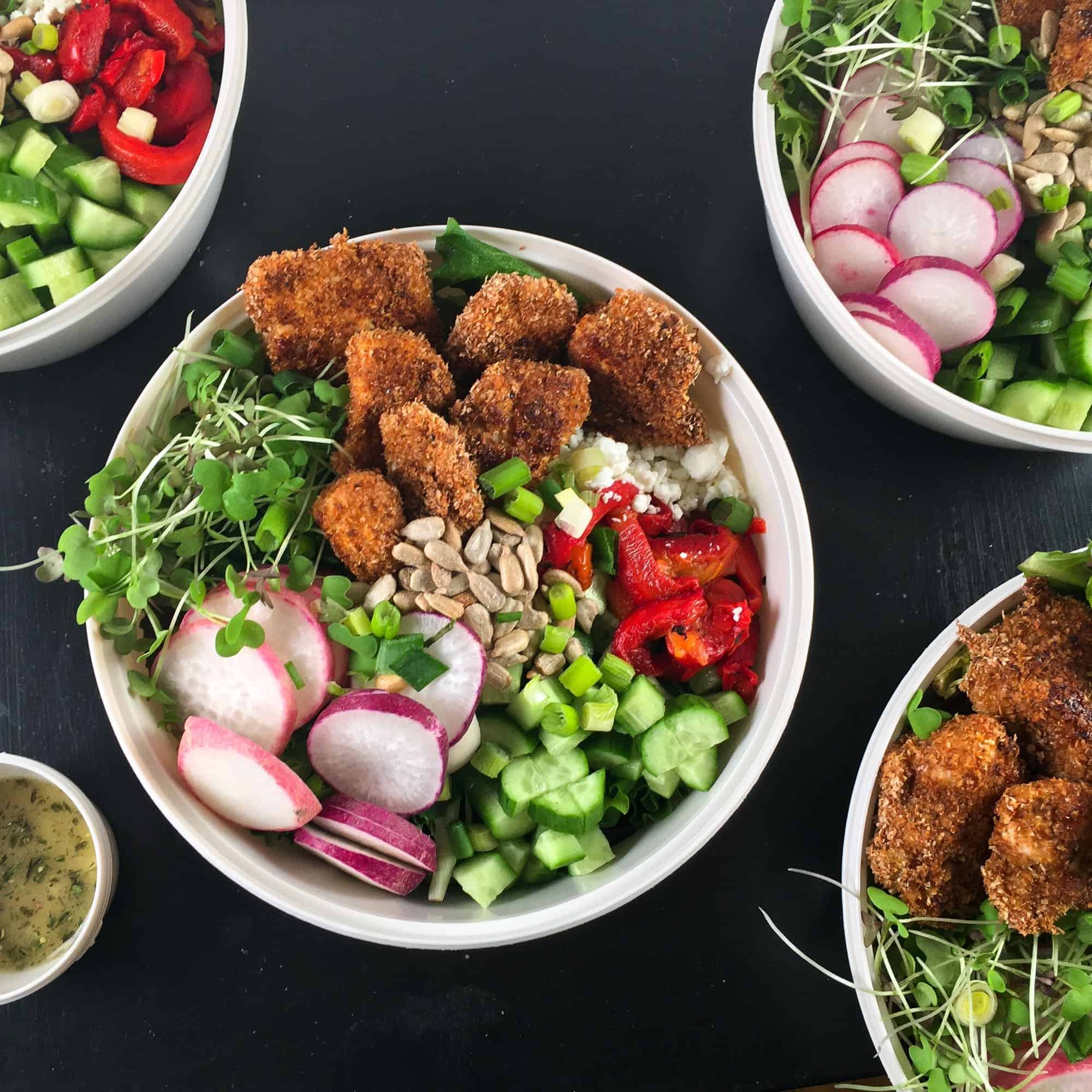
This popcorn chicken salad recipe is an update from 2020 with new photos, recipe tweaks, more nutrition info, and a new recipe video. Happy eating!
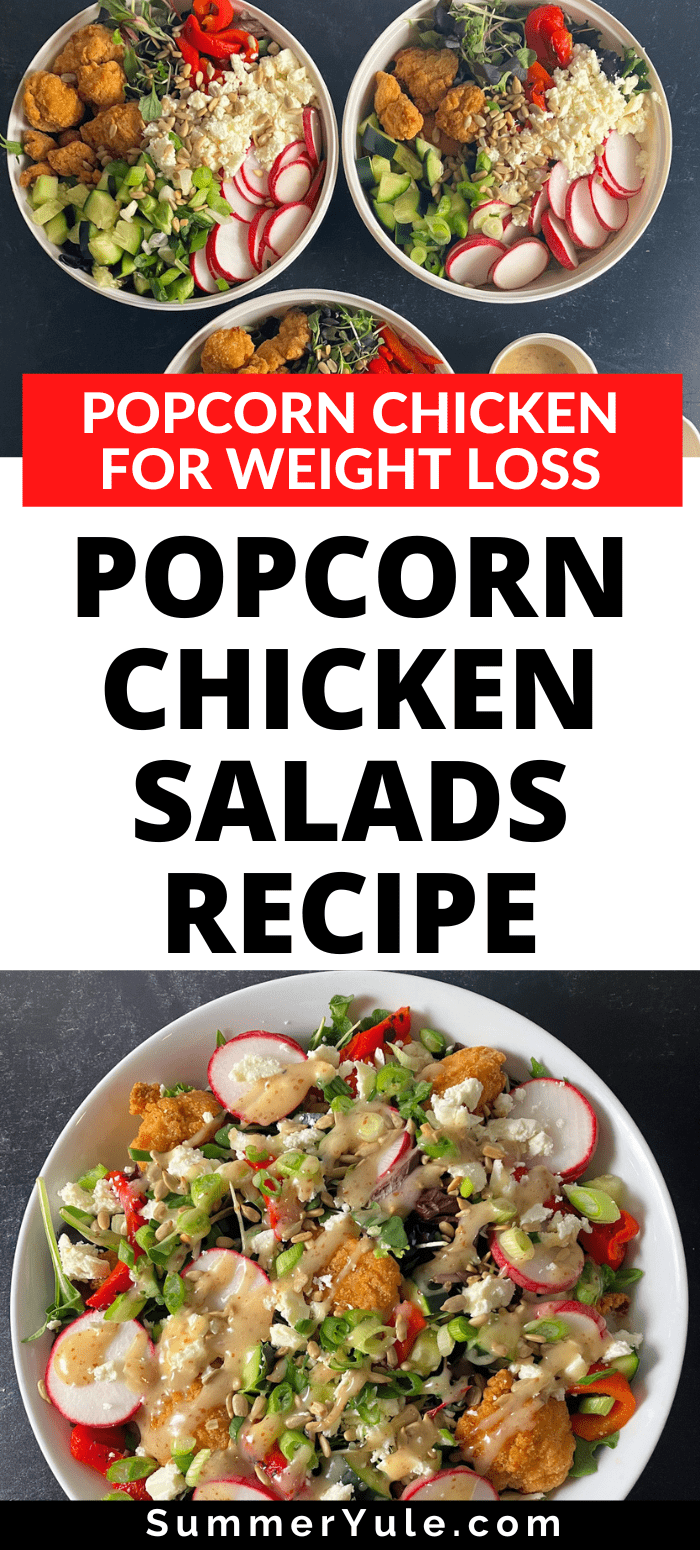
Join our community! Subscribe for all of the latest and greatest recipes, and follow me on Facebook, Pinterest, Instagram, and YouTube!

Hello! I'm Summer, a registered dietitian and home chef who loves to cook, eat, and create high quality content for you! Every recipe on this site has been tested by me to help ensure your success in the kitchen. All eaters are welcome here 🙂


ปั้มไลค์ says
Like!! Great article post.Really thank you! Really Cool.
Summer Yule says
Thank you for leaving a rating!
Terrified Amateur says
Great idea, Summer! You've found a way to give us crispy fried chicken, while rendering the Dutch oven filled with oil an unfortunate memory. A fading memory too.
Not to focus on a side story, but I really have had a hankering lately to grow my own microgreens. What better time to do that than over the next couple months, as we thin out the maturing plants? Much more dependable a source, too, than is the local market, which features baby greens, maybe, once a month or so.
As usual, Summer, your site holds high Inspiration's Torch!
Summer Yule says
That is a really terrific idea about eating the thinned out greens. I ended up doing that today with my lettuce! Something I've noticed is that the lettuce is growing far slower than the seeds that were intended to be harvested as microgreens. I'm not sure why but I'd love to figure out if there is something I could be doing to help the lettuce a little more. They get the same potting soil (from the same bag) as the microgreens.
Terrified Amateur says
That's baffling, Summer, as greens seem to like cool, cloudy weather, which has defined April so far. Odd, too, as winter was sub-par, and March was on the warm side. I know my mustard greens and arugula are delighting in the chill.
Is it possible your lettuce is a variety formulated for warm-weather growth (there are a few)? You're doing everything else right, potting soil, cool temps and all. Obviously, your other botanical attempts show you to have a green thumb. Why is lettuce holding out on you? Sprechen sie English, greens?
Summer Yule says
That is a good theory! It's supposed to grow well in my gardening zone but perhaps it will fare better once the weather warms up. What else have you decided to grow this year, aside from the arugula and mustard you've mentioned? You've got the makings of a very spicy garden there!